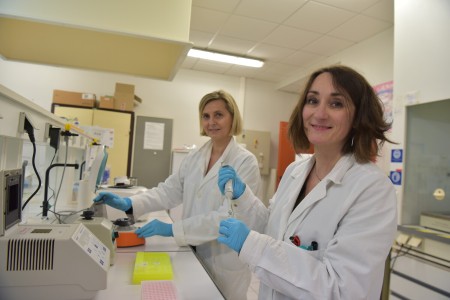Research: ANR Interference to control pests and protect bees
At the Functional Signalling of Ion Channels and Receptors Laboratory (SiFCIR), Valérie Raymond and Delphine Goven are conducting research into new strategies for controlling invasive insects. They will be actively involved in the ParaGluRSite project run by the French National Research Agency (ANR), which began in March 2025.

Valérie Raymond et Delphine Goven.
Bees are essential to our food supply and also embody biodiversity. Unfortunately, approximately 40% of bee colonies have been decimated in less than ten years in Europe. One cause is the use of pesticides to eliminate certain arthropods such as aphids, ticks and varroa mites. They attach themselves directly to bees, feed on haemolymph (the equivalent of blood in insects) and can transmit viruses.
The ParaGluRSite project is based on the interactions between bees and varroa mites in order to develop new ways of controlling certain arthropods. "We have filed a patent for a new technology to combat aphids, and the Max-Mousseron Institute of Biomolecules (IBMM) at the University of Montpellier contacted us to know if this work could be transposed to other arthropods," explains Valérie Raymond, director of SiFCIR laboratory. "As part of the ANR project, the aim is to develop new strategies for controlling varroa mites, ticks and aphids while protecting bees and, more broadly, the environment," adds Delphine Goven, lecturer and researcher in biology and co-leader of the project.
An innovative strategy to protect bees and the environment
This patented technology is RNA interference, a biological mechanism "used" by cells to control gene expression by reducing or preventing the production of certain proteins essential to the functioning of the nervous system.
For this project, Valérie Raymond and Delphine Goven will first identify these proteins and then design double-stranded RNA molecules (two nucleotide chains) that are complementary to the messenger RNA of the target genes identified in the arthropod of interest. "Interfering RNA directed against these new neural targets is an innovative strategy for controlling certain arthropods while preserving bees and the environment."
In addition to this technology, compounds extracted from essential oils and peptides derived from spider and ant venoms administered by nanovectorisation will also be tested. "The safety of molecules capable of blocking the movement of Varroa mites will be assessed using locomotor and cognitive behavioural tests on bees," the researchers conclude. "We will test whether this approach can also be extended to the Ixodes ricinus mite, the most widespread tick in France, as well as to the Acyrthosiphon pisum aphid, which ravages legume crops."
